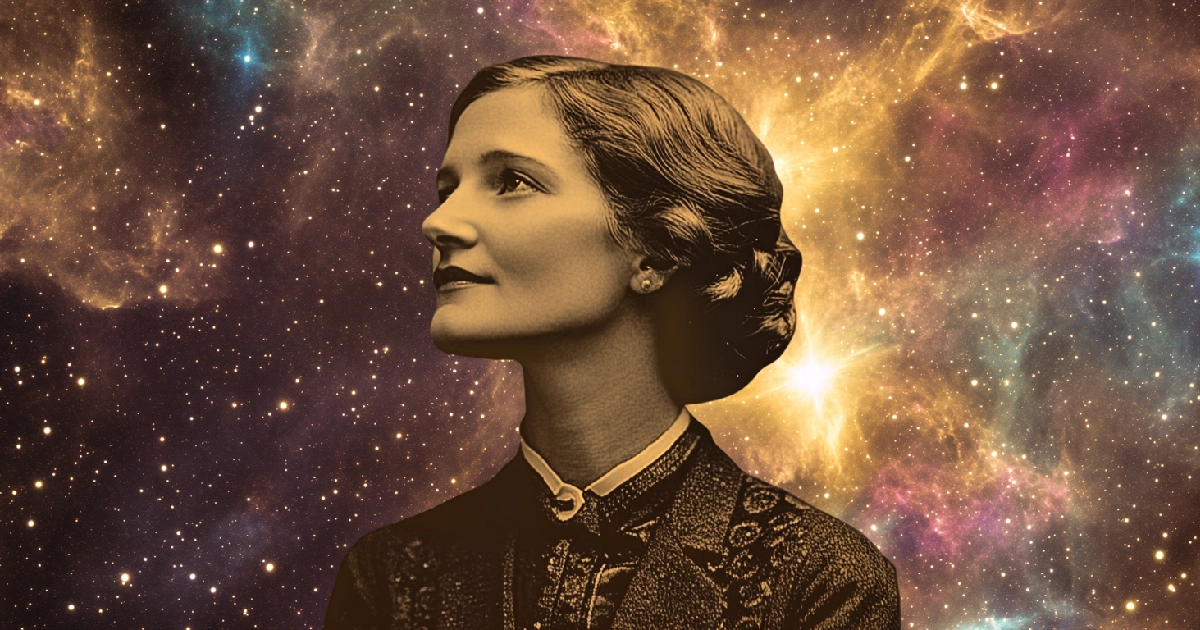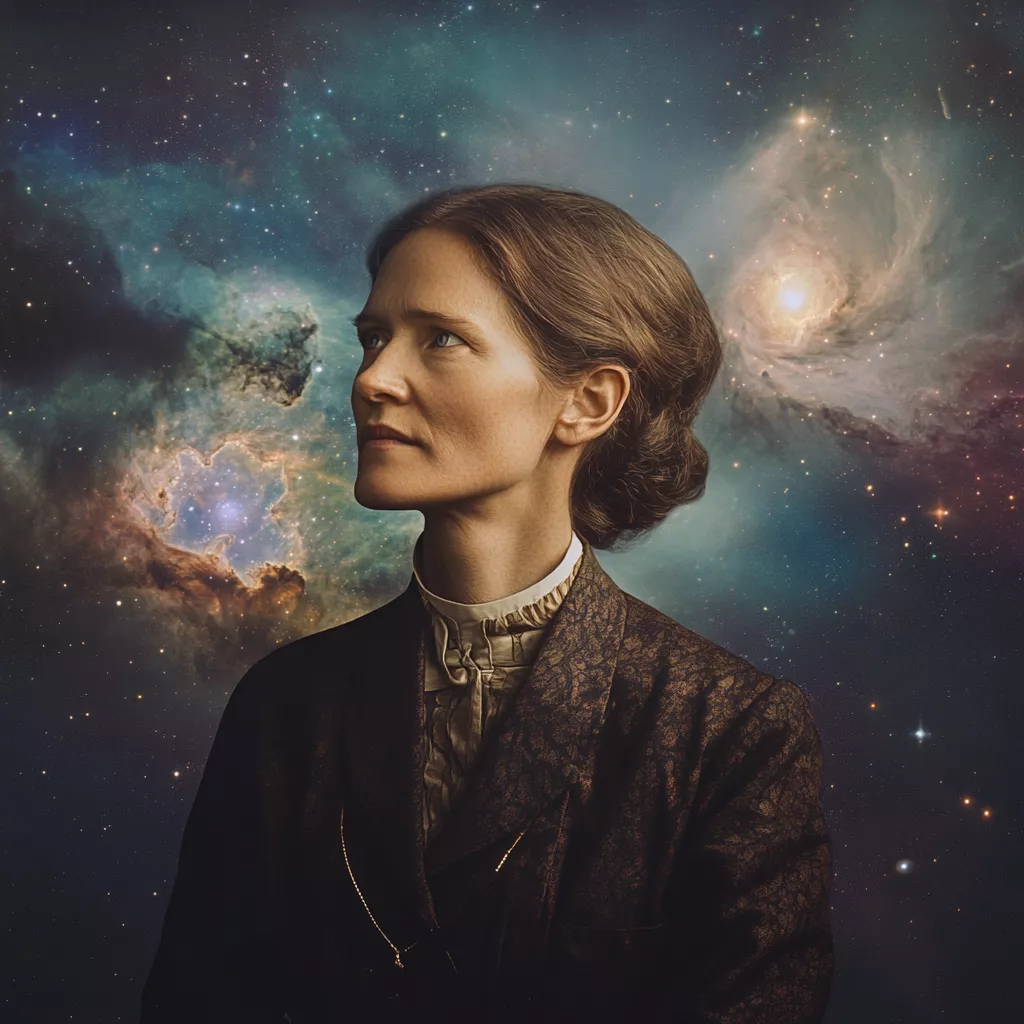

Imagine a world where the universe's greatest secrets were whispered by the stars, but almost no one was listening. Now, imagine a young woman, armed with nothing but brilliance, relentless curiosity, and a smidgen of rebellion against the patriarchy, determined to listen. This is the story of Cecilia Payne, the woman who transformed our understanding of the cosmos, all while navigating a galaxy of doubt, sexism, and scientific dogma. Grab your telescope and maybe a cup of cosmic tea—this is going to be one stellar ride.
Born in Wendover, England, in 1900, Cecilia Payne was destined to be extraordinary, although the universe took its sweet time revealing her true calling. Her father, Edward Payne, was a historian, and her mother, Emma, a singer—meaning Cecilia was genetically programmed to mix intellect with a touch of artistry. With a childhood steeped in books and music, young Cecilia initially gravitated towards the piano, probably dreaming of serenading the stars one day.
But alas, the universe had other plans. The turning point came at age 12 when her father passed away, leaving the family financially strained. Cecilia's childhood took on a new seriousness, and so did her studies. She found herself drawn not to the piano keys, but to the mysteries of science. By the time she entered St. Paul's Girls' School, her passion for the natural world had fully ignited. Flowers, bugs, rocks—you name it, Cecilia was into it. She once recalled that her bedroom resembled more of a natural history museum than a teenage girl’s sanctuary. And we’re not just talking about a few butterflies pinned to a board; we're talking full-blown botanical experiments and geological surveys happening right next to her bed.
By 1919, Cecilia had made it to Newnham College, Cambridge—an achievement that was the equivalent of reaching the moon for women in science at the time. Her mother, still nursing hopes of a musical career for Cecilia, wasn't thrilled. But Cecilia? Oh, she was having none of that. She plunged headfirst into the scientific courses, particularly fascinated by physics. Yet, the atmosphere at Cambridge was, let’s say, less than welcoming for a woman in the sciences. While her male counterparts were handed degrees upon completion, Cecilia received...a certificate of attendance. It was like winning an Olympic gold medal and being handed a "thanks for participating" ribbon.
During this time, Cecilia attended a lecture by Arthur Eddington about his expedition to observe the 1919 solar eclipse. Eddington's observations confirmed Einstein's theory of general relativity, a fact that left the scientific community in awe. For Cecilia, this lecture was like the universe itself had reached down and tapped her on the shoulder, saying, "Hey, you! Get up here, we’ve got work to do!" And so, inspired by the mysteries of the stars, Cecilia decided to pivot her focus to astronomy.
In 1923, Cecilia Payne set sail for the United States to study at Radcliffe College, which was then a women's college affiliated with Harvard. Why Harvard? Well, because back in merry old England, the opportunities for women in science were about as plentiful as water on Mars. Harvard, however, had a flourishing astronomy program—thanks to the Harvard College Observatory, which was practically overflowing with data just waiting to be analyzed. The observatory was helmed by Harlow Shapley, a man with a nose for talent, and it didn’t take long for him to realize that Cecilia was about to rock the world of astronomy .
And rock it she did.
Cecilia Payne’s most famous accomplishment is one that would make even the most modest of people strut like a peacock. Her Ph.D. thesis, completed in 1925, was the first of its kind at Harvard—literally. She was the first person to earn a Ph.D. in astronomy from Harvard-Radcliffe, and her thesis would later be described as "the most brilliant Ph.D. thesis ever written in astronomy." No big deal, right?
Let’s break down what made her thesis so revolutionary that it left the scientific community both awestruck and a little bit jealous. Up until Payne’s work, scientists believed that stars were composed of the same elements as Earth, with iron being the most abundant. Cecilia, however, decided to double-check this assumption. Using ionization theory, which explains how atoms lose or gain electrons, she analyzed the light from stars—essentially turning starlight into a cosmic grocery list.
What she found was nothing short of mind-blowing: stars were composed primarily of hydrogen and helium. In fact, hydrogen was about a million times more abundant in stars than any element found on Earth. This meant that the universe was not, as previously thought, an oversized version of Earth. It was something entirely different—something much more intriguing.
Payne’s findings were revolutionary but controversial. Her conclusion directly contradicted the established beliefs of the time. When she submitted her thesis, Henry Norris Russell, a prominent astronomer at Princeton, advised her to downplay her conclusion. Why? Because it was so radical that he feared it might ruin her career before it even started. Payne, reluctantly, followed his advice, but her findings were so rock-solid that they couldn't be ignored for long.
A few years later, Russell did his own research and came to the same conclusion as Payne. In a classic move of "better late than never," he published his findings and graciously gave Cecilia Payne the credit she deserved. While it was nice to get recognition from the scientific community, it was also a bittersweet reminder of how often women in science had to wait for their male counterparts to endorse their work before it was taken seriously. Nevertheless, Payne’s work laid the foundation for our current understanding of stellar composition and fundamentally changed the way we see the universe.

Cecilia Payne didn’t stop with her Ph.D. She continued to work at the Harvard College Observatory, where she churned out a steady stream of research that contributed significantly to our understanding of stars and the broader universe. Her work included studies on variable stars, the structure of the Milky Way, and the atmospheres of stars. But despite her groundbreaking research, Payne was not immediately offered a faculty position at Harvard. In fact, she spent several years as a "technical assistant," which was essentially the academic version of "you're doing a professor's work, but we're going to pay you like an intern."
It wasn’t until 1956—yes, you read that right, 1956—that Cecilia Payne became the first woman to be appointed a full professor at Harvard. She also became the first woman to head a department at the university, breaking yet another glass ceiling in a career full of them. Along the way, she mentored countless students, including many women, helping to pave the way for the next generation of astronomers.
In 1933, Cecilia Payne married Sergei Gaposchkin, a Russian-born astrophysicist who had fled the Soviet Union. The two met at Harvard, where Sergei was working as a research assistant. Their relationship was one of intellectual partnership as well as love; they collaborated on various research projects, particularly on variable stars. The couple had three children, and by all accounts, Payne was as dedicated to her family as she was to her work. Balancing a career in a male-dominated field with family life wasn’t easy, but if there was one thing Cecilia Payne excelled at, it was doing what everyone else said was impossible.
Cecilia Payne passed away in 1979, leaving behind a legacy that is nothing short of astronomical. Today, her name is spoken with reverence in the world of astronomy, her contributions acknowledged as cornerstones of our understanding of the universe. But during her lifetime, Payne had to fight for every scrap of recognition, navigating a world that was often unkind to women with ambition.
Her story is not just one of scientific accomplishment, but also one of perseverance. She was a woman who dared to ask questions that no one else was asking, who dared to challenge the status quo, and who refused to be silenced by the towering figures of her time. Payne’s work opened the door for women in astronomy and other scientific fields, showing that brilliance knows no gender.
Cecilia Payne’s life is a testament to the power of curiosity, determination, and just the right amount of stubbornness. Her work didn’t just change our understanding of stars; it changed our understanding of the universe itself. She proved that sometimes, the most profound discoveries come from those who are willing to question everything—even the most "settled" science.
So, the next time you look up at the night sky, remember that those twinkling stars are not just pretty lights; they’re cosmic storytellers, revealing the secrets of the universe to those who are brave enough to listen. And if you listen carefully, you might just hear a whisper of Cecilia Payne, the woman who taught the stars how to speak.